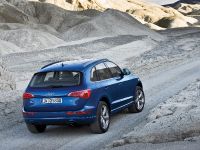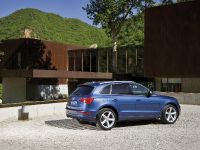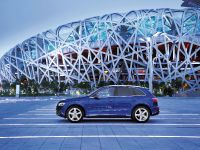Audi Q5 earns highest NHTSA grades in front and side impact crash testing
The unmistakable new Audi Q5 crossover vehicle just earned a Top Safety Pick award for 2009 from the Insurance Institute for Highway Safety (IIHS), and received the highest front and side crash ratings from U.S. safety regulators.
Results from rigorous IIHS testing released today showed the 2009 Audi Q5 received a "good" rating in all three crash measurements: side impact, offset frontal and rear impact seat tests. The five-star ratings that the Audi Q5 received from the U.S. National Highway Traffic Safety Administration (NHTSA) represent the top marks possible in front and side crash tests.
The Audi Q5 earned five-star ratings for driver and passenger protection in NHTSA frontal crash tests, and five-star ratings for front and rear protection in NHTSA side impact crash tests.
"Audi engineers place unwavering emphasis on the protection of motorists and their passengers," said Johan de Nysschen, President, Audi of America. "These outstanding ratings for the Audi Q5 confirm our intent to meet the most rigorous safety standards found anywhere in the world."
To qualify for the IIHS Top Safety Pick award, a vehicle must earn the highest rating of "good" in the Institute's front, side, and rear tests and must be equipped with electronic stability control, which Audi installs as standard equipment on every model it produces. The Q5 joins the A3, A4, A6 and Q7 as Audi models that have merited IIHS Top Safety Pick designation.
The Audi commitment to safety goes beyond crash test safety ratings to include a comprehensive list of active and passive safety features. Every Audi sold in the U.S. has standard four-wheel disc brakes with anti-lock braking system (ABS), an electronic stability program, daytime running lights (DRL) and a standard tire pressure monitoring system. The Audi Q5 also features quattro permanent all-wheel standard on all models, providing high levels of active safety and traction on virtually any surface. All of these features are designed to help reduce the chances of a collision.













